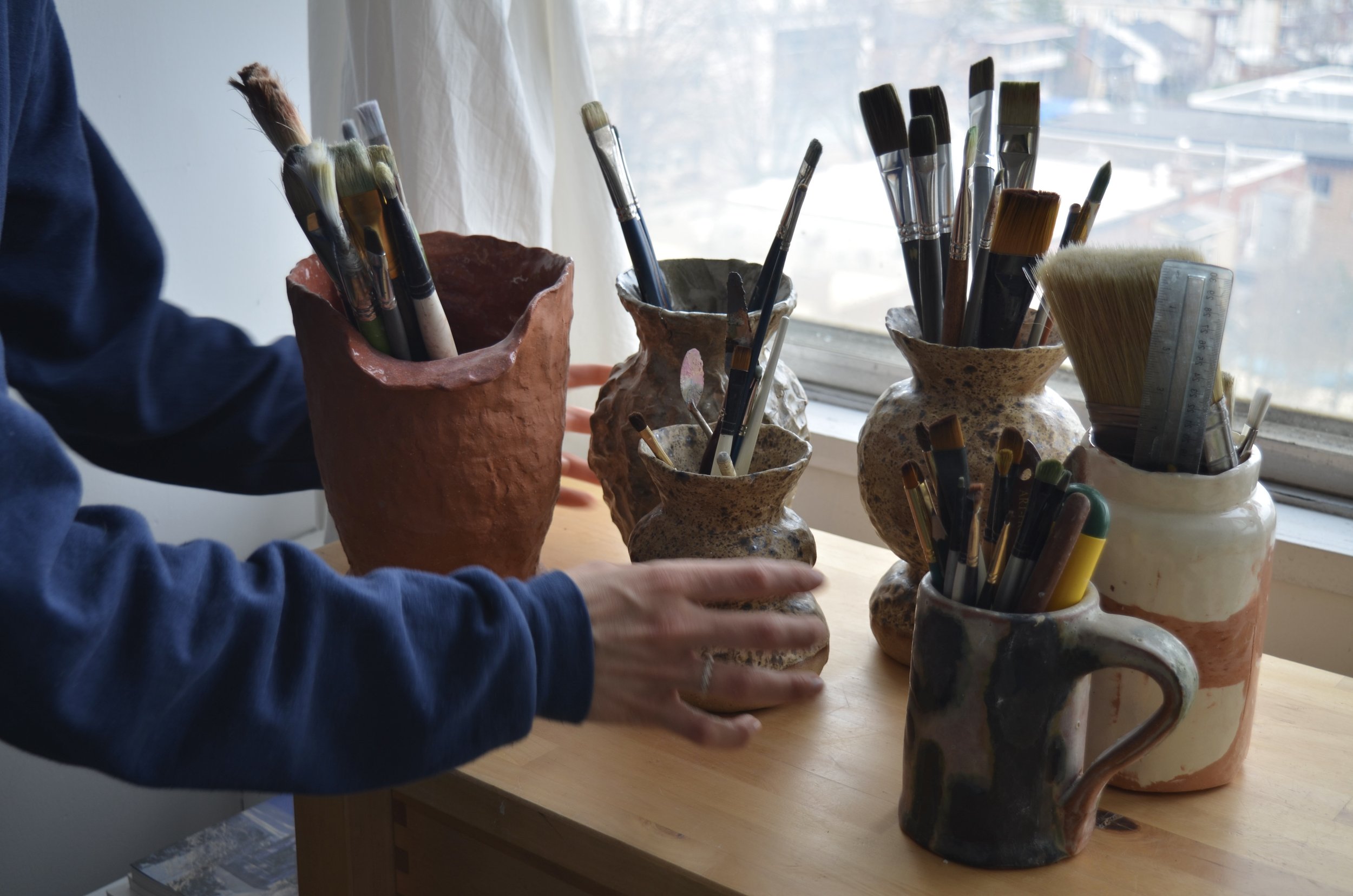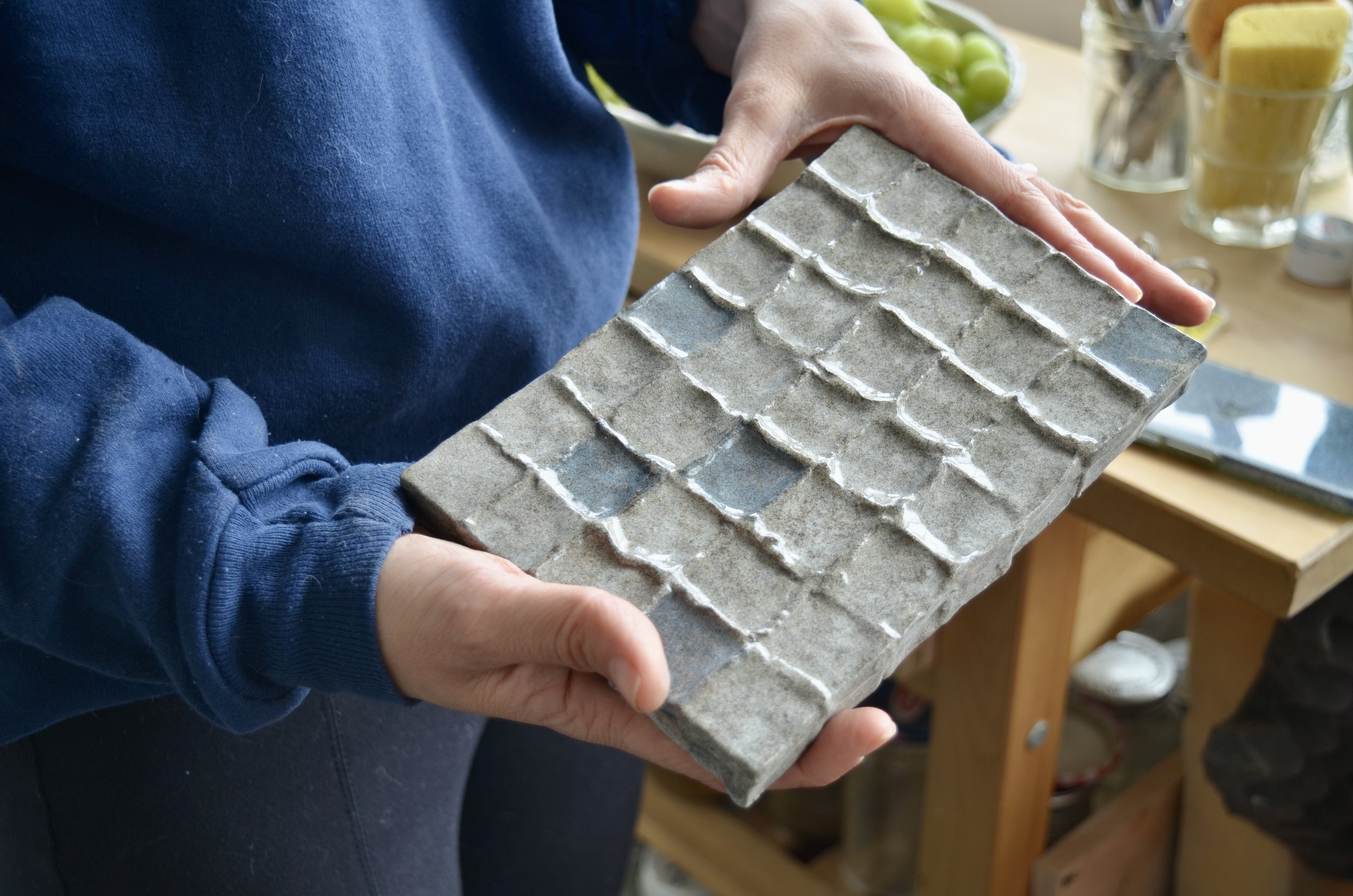This spring, art_works’ most recent studio visit took place in the tranquil creative space of Béatrice Côté. We encountered the Montréal-based artist in the process of preparing for “Clay Court,” a solo exhibition at Espace Loulou that would take place the following week.
Béatrice’s interdisciplinary art practice evinces a dual interest in painting and ceramics. In her recent body of work, she experiments with this convergence of disciplines and questions their boundaries. Broad sections of canvas house delicate tiles while ceramic wallworks ressemble fossilized paintings, and scenes of lush floral dances are juxtaposed with ordered porcelain grids. The resulting works simultaneously evoke warm memories and the resilience of nature within the built environment. They recall the tenacious florets that push through stretches of pavement, and remind us of the intricate and enduring beauty of our surroundings.
Amidst a collection of large-scale stretchers and ceramic debris, we discussed fusing passions and art forms, lauded the importance of alternative exhibition spaces, and ruminated on material insights gleaned from an artist residence spent in Rwanda.
The ceramic vignette for a painting of clouds; work in progress
art_works: Your interdisciplinary art practice spans painting and ceramics. How do both aspects of your work inform one another? And how have you been looking to fuse them?
Béatrice Côté: I often ask myself why I want to pursue both painting and ceramics instead of focusing on one or the other, and it is a difficult question to answer. I started by studying mostly ceramics at Concordia for my undergraduate degree, but more recently rekindled my passion for painting.
From a practical standpoint, both aspects are quite simply linked through my desire to simultaneously work within two disciplines, and my attempts at finding a good balance between them. Other than that, I think that my works with painting and clay are fundamentally linked through my recent explorations with colour. In general, colour is what guides me – particularly greens, blues, reds. There are infinite possibilities to mix colours. In my ceramic practice, I work a lot with pigment, rather than glazes. The other day, I was working with a pigmented clay that I thought would turn out to be a pink terracotta. But since I had added blue to the mix, it turned out to be the colour of the sky – the blue pigment was so strong that it completely overtook the other hues. So in the end I was left with a deep blue, and I thought to myself: “This ceramic vignette might work well with a painting of clouds.” And it does!
I am very interested to see how the fusion of painting and ceramics will continue to evolve in my practice. It definitely requires a lot of discipline and organization in terms of material, space, and mental capacity, since you are constantly moving between two very different gestures and worlds. For me, painting is a lot looser, while ceramic is more focused and functional, and requires more preparation. When I work with clay, I find myself in a completely different zone than when I make my paintings. I love that it provides me with two very different tasks, and I love passing from one to the other, especially when I become too absorbed by one project. I will often paint, and then take a break to work with clay. When that gets too dusty, I clean, and begin painting again. It helps me to switch between the two, and to avoid getting caught up in one single thing.
a_w: When and how did you first discover your passion for pottery and ceramics?
BC: Nothing too romantic to start with. When I was younger, I had a lot of difficulty concentrating at school, and would often daydream. I took an aptitude test that told me that my visuospatial and visuoconstructive abilities were very strong. This unlocked something inside of me. My parents were also always encouraging me to explore a field that was crafty, since I always had an artistic instinct. At the same time, one of my friends had suggested that I join her for a pottery class, and I immediately felt a strong connection to that materiality. After that, I felt compelled to move beyond the strictly functional and to learn more about ceramic as an art form. A year later, I then moved to London, where I started taking drawing and sculpture classes. I would say that is when it clicked that I wanted to pursue this full-time, and I finally enrolled in art school. It was never something that I expected – it was truly an evolution of coming into my own.
a_w: You are in the process of preparing for a show that will open next week at Espace Loulou. Tell us about this exhibition – what are some themes that you will be exploring?
BC: In my current body of work, I am very interested in exploring movement, and capturing the blurry, fuzzy and vague. I also love the sensation of a total lack of texture, and how everything remains at almost the same level. There is no demarcation or paint accumulation, and the result is very smooth. I also frequently return to floral scenes and colours, but am working on creating additional moods, either through the addition of people or objects. I am striving to get to a place from which I can create a distinctive language that can be either figurative or abstract, or a little bit of both... I still feel like I am at the beginning of my practice, and that there is still so much to explore!
This show marks the first time that I make several works simultaneously, i.e. producing in the aim of exhibiting. It is quite a difficult feat at the beginning of one’s career. To reassure myself in this task, I think of musicians who are coming up with an album of ten songs. There will obviously be one song that is an immediate hit and takes off, a song for which there was an ease of creation. On that same album, there are other songs that are perhaps less popular, but they make that hit live as a larger ensemble. So I often look at the exhibition through this analogy – some works will be harder to pin down, while others will appear immediately and energetically.
Installation view of “Clay Court,” solo exhibition at Espace Loulou, 2023. Photo credit: William Sabourin
a_w: Montréal has so many great alternative exhibition spaces. As a Montréal-based artist, what would you say sets this art scene apart from other places?
BC: So many things, but definitely our strong community. Most of the time, the alternative spaces in Montréal are run by artists or young curators. They require a lot of work, which means doing the job for the love of art and for the people with whom you are sharing your practice (a big thank you to the Loulou team!). It is very hard to keep these spaces alive. They often come and go because they are linked to artists who are growing and evolving their practices, but they also rely on the current state of the buildings. The Montréal real estate market ultimately dictates where artists have the capability to organize these amazing centers.
a_w: Where do you find yourself drawing inspiration from recently?
BC: I work a lot from photos that I take when walking through the city, or on nights out with friends. I often come back to the camera roll on my cell phone. My mother lives in the Eastern Townships, so I take a lot of photos of wheat fields, as well as flower boxes in the streets. I also work a lot from photos of friends, moments, memories. For this portrait of a boy making a face, for example, I was instantly drawn to the gesture, the energy, the moment – I needed to have it come through, and I finished it in two days. I would say that I draw my inspiration mostly from photos, from which I try to draw out a mood, colour, action, or movement, before seeing how I can rework it. My subject matter is always drawn directly from life, and does not arise from my imagination. I like to think of myself as an inquisitive explorer who likes to see and touch everything – an explorer who is very curious, with a great sensibility to everything around them.
a_w: Tell us about your recent residence at Inshuti Art Gallery in Rwanda in 2021. How was that experience for you, and what did you learn during that time?
BC: This would be a very long story to tell! I learned so much. I loved seeing what materials the artists worked with. It was incredible – they would leave for a full day to gather materials, dig, and fill huge coffee bags with clay that they would bring back to the studio. They would then sort out all of the big rocks, weeds and branches, before treating the clay, letting it dry, and crushing it into smaller pieces. A lot of time was spent gathering material as part of their practice. This opened my eyes to questions of material and resources. When I got back, I was very motivated to start digging, but quickly found that it was difficult to implement local clay into my practice full-time. I tried it for smaller quantities, but it turned into more of a type of research. There is only one clay store in Montréal that sells clay from Toronto, the States, or Alberta, but the product still comes from elsewhere. We don’t really have a refinery in Montréal anymore. So I am definitely thinking about collecting clay and treating it in the future, but I still have a lot to learn, and for time-being, I am waiting for the right project.
To sum everything up, I guess what has struck me the most from this experience was the realization that ceramic is simply the earth beneath our feet. It isn’t more complicated than that… The title of my upcoming exhibition is “Clay Court” – I learned to play tennis on clay, and thought that it was funny to think that the courts on which I was playing were essentially the basis of ceramics.
a_w: Now that you are back in Montréal, what is your favourite part of your current studio space and routine?
BC: Definitely the windows and bright light that streams into my space all day. It is such a privilege. My favourite studio moments happen when I am in the best of moods and full of energy, and when my playlist or podcast is on point! The most satisfying days happen when everything is aligned and you feel that creative energy extending over a longer period of time. It is in those moments that you really understand why you are an artist. I am quite new to the art world, so having a space fully dedicated to creation is amazing.
As for my studio routine, I usually make coffee, get into a groove, feel zen, and sometimes chat with Antoine O’Donoughue (my studio-mate). Chabanel is also a great area to be located. I can quickly take the bus from my place, or walk for 30 minutes. I can also go to the Intermarché next door and pick up a sandwich for $6 – I go at noon and line up with everyone else… All of those simple parts of the routine are just so enjoyable.
A view of Béatrice’s studio space















